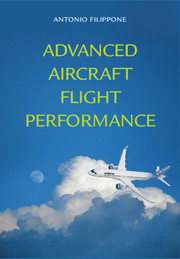Book contents
- Frontmatter
- Contents
- Tables
- Preface
- Nomenclature
- Technology Warning
- 1 Prolegomena
- 2 Aircraft Models
- 3 Weight and Balance Performance
- 4 Aerodynamic Performance
- 5 Engine Performance
- 6 Propeller Performance
- 7 Airplane Trim
- 8 Flight Envelopes
- 9 Take-Off and Field Performance
- 10 Climb Performance
- 11 Descent and Landing Performance
- 12 Cruise Performance
- 13 Manoeuvre Performance
- 14 Thermo-Structural Performance
- 15 Mission Analysis
- 16 Aircraft Noise: Noise Sources
- 17 Aircraft Noise: Propagation
- 18 Aircraft Noise: Flight Trajectories
- 19 Environmental Performance
- 20 Epilogue
- Appendix A Gulfstream G-550
- Appendix B Certified Aircraft Noise Data
- Appendix C Options for the FLIGHT Program
- Index
- References
11 - Descent and Landing Performance
Published online by Cambridge University Press: 05 January 2013
- Frontmatter
- Contents
- Tables
- Preface
- Nomenclature
- Technology Warning
- 1 Prolegomena
- 2 Aircraft Models
- 3 Weight and Balance Performance
- 4 Aerodynamic Performance
- 5 Engine Performance
- 6 Propeller Performance
- 7 Airplane Trim
- 8 Flight Envelopes
- 9 Take-Off and Field Performance
- 10 Climb Performance
- 11 Descent and Landing Performance
- 12 Cruise Performance
- 13 Manoeuvre Performance
- 14 Thermo-Structural Performance
- 15 Mission Analysis
- 16 Aircraft Noise: Noise Sources
- 17 Aircraft Noise: Propagation
- 18 Aircraft Noise: Flight Trajectories
- 19 Environmental Performance
- 20 Epilogue
- Appendix A Gulfstream G-550
- Appendix B Certified Aircraft Noise Data
- Appendix C Options for the FLIGHT Program
- Index
- References
Summary
Overview
The descent deals with that segment of the flight when the airplane decreases its flight altitude in a controlled mode. Landing still requires good pilot skills, which are best appreciated in bad weather conditions. The descent can be a large portion of the stage length, reaching in excess of 100 n-miles. Several distinct phases are identified. We will consider separately the phase of en-route descent down to 1,500 feet altitude above the airfield (§ 11.1) and the final approach down to ˜50 feet above the airfield (§ 11.2).We also discuss two unconventional flight procedures: the continuous descent approach (§ 11.3), which has some advantages in terms of fuel consumption and noise emissions, and the steep-descent approach, which is a more complex manoeuvre (§ 11.4). We analyse the case of airplanes placed on holding stacks (§ 11.6) and optimal performance issues. Landing consists of an airborne phase and a landing run (§ 11.7). Effects of side gusts are considered, including crab landing and wing strike. This chapter ends with considerations of go-around trajectories, which are associated to aborted landing (§ 11.8).
KEY CONCEPTS: En-Route Descent, Continuous Descent Approach, Steep Descent, Unpowered Descent, Holding Procedure, Landing Performance, Crab Landing, Go-Around.
En-Route Descent
The aircraft starts descending from its cruise altitude well ahead of its destination. The flight computer will indicate the distance to the airfield and the estimated en-route descent, that is, the distance and time to landing, based on a number of factors, including speed, altitude and winds.
- Type
- Chapter
- Information
- Advanced Aircraft Flight Performance , pp. 300 - 327Publisher: Cambridge University PressPrint publication year: 2012



